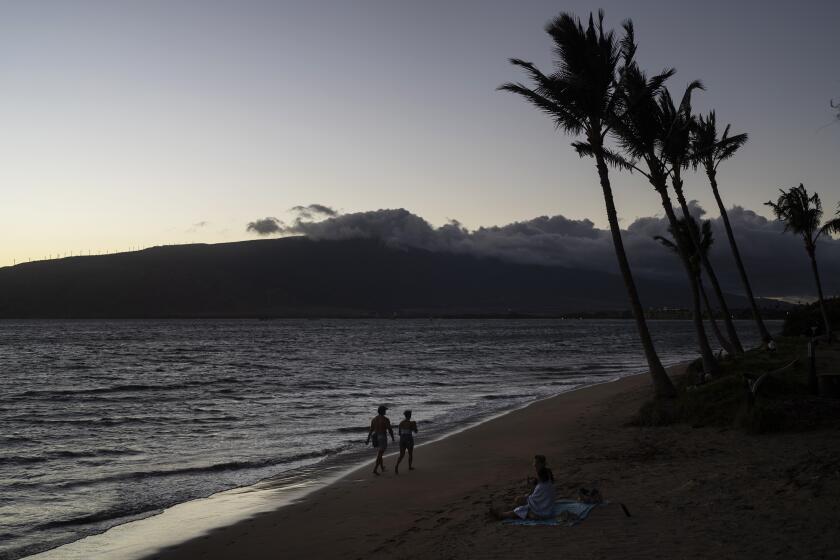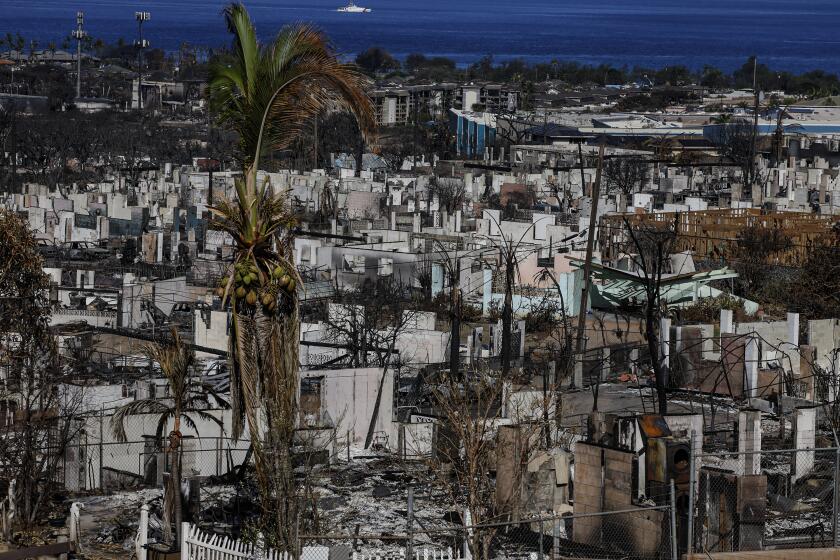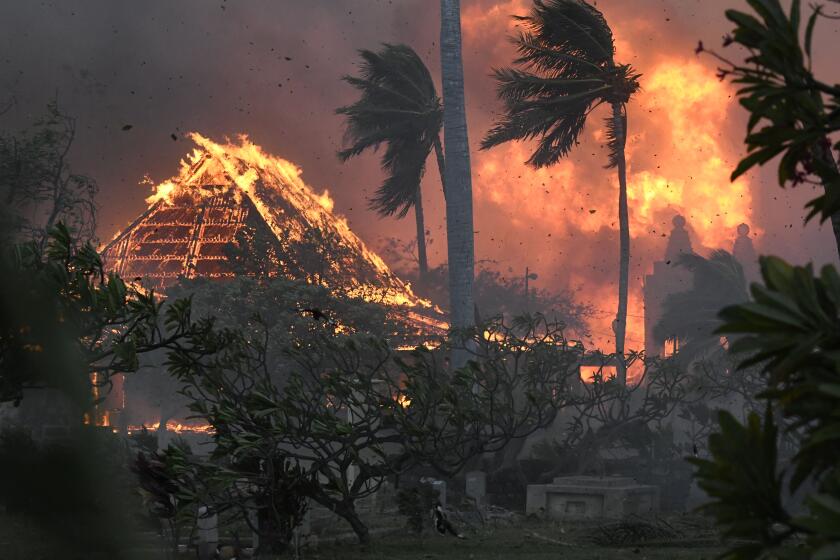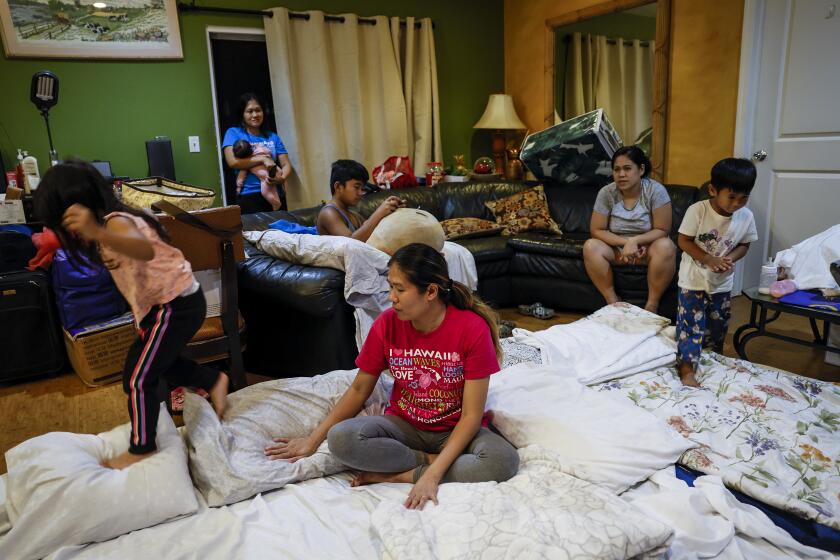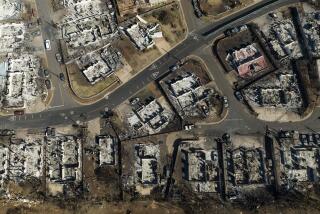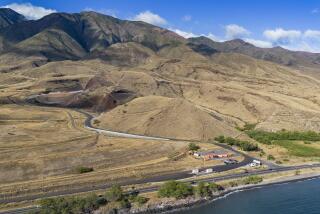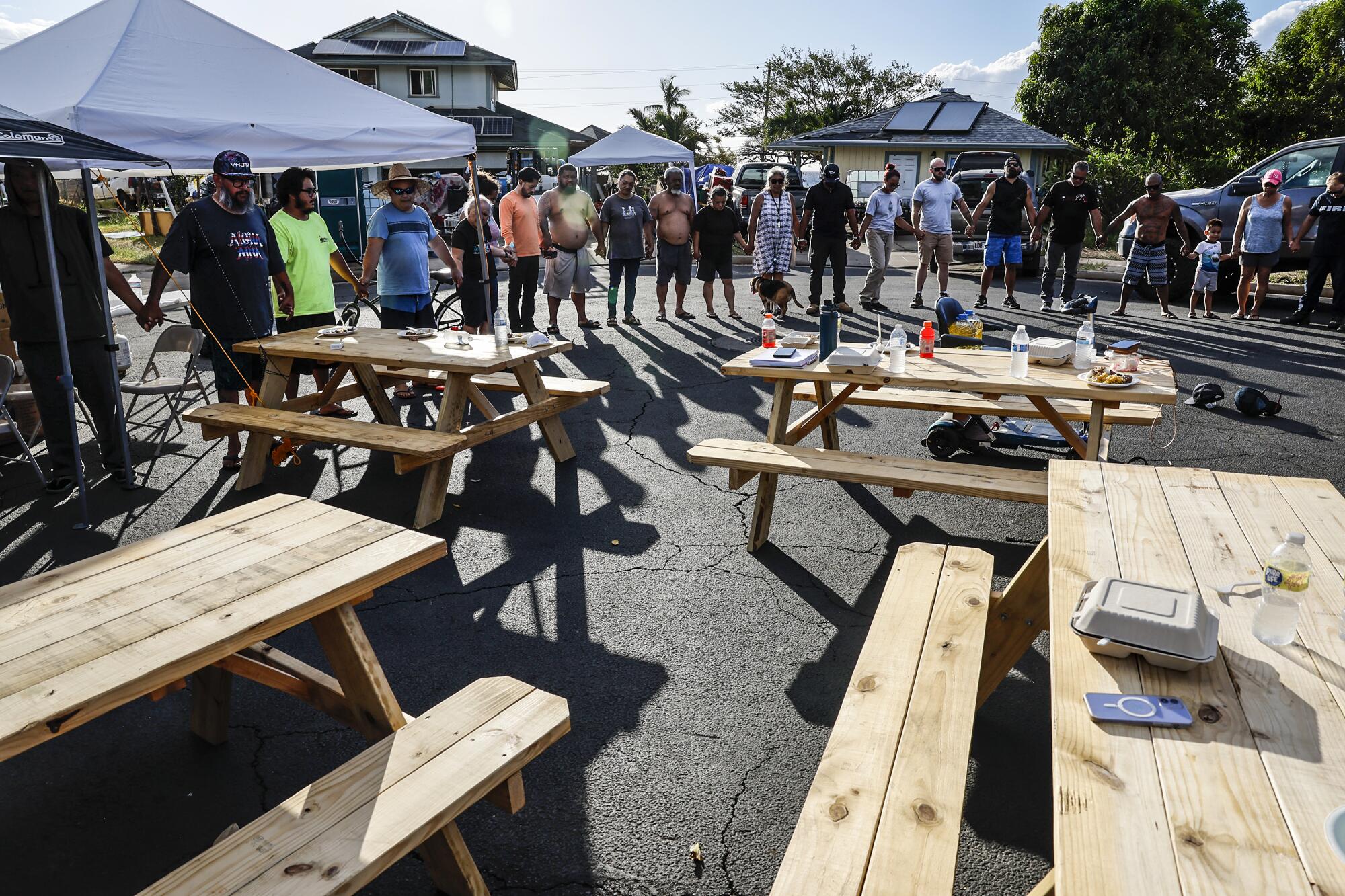
- Share via
KIHEI, Hawaii — The line at Paia Fish Market usually extends so far down the main drag that staffers can’t see the end of it through their front window.
But that hasn’t been the case as of late, with tragedy on Maui slowing foot traffic in typically busy spots to a trickle.
“Today is the lowest it’s been so far,” said Lehua Jimenez, 21, a cashier at the popular restaurant in Paia — a windsurfing destination on Maui’s North Shore. “It’s continually decreasing.”
Paia is half an island away from Lahaina, where the restaurant’s other location was among more than 2,000 structures destroyed in a wildfire this month. But the Paia location was seeing about a fifth of typical sales, said Jimenez. The Maui native and her co-workers were far from the only ones feeling the economic pain.
The restaurant had only been open a few hours on a recent weekday and five people had already come in looking for jobs, Jimenez said. Not that there were any to be had, there or elsewhere.
Hawaii and Maui leaders urge tourists to act with empathy when visiting the popular island as people mourn after deadly fires. Here’s what you should know.
Immediately after the Aug. 8 blaze devastated the historic town of Lahaina, killing at least 115 people and layering shock and grief across the island, the message from officials and on social media seemed clear: Tourists should stay off Maui.
But nearly three weeks after the deadliest U.S. wildfire in more than a century, the sharp drop-off in visitors is sowing a different kind of fear across an island where tourism dominates the economy. In recent days, officials and others have started to sound alarm bells, begging visitors to return to other parts of Maui.
“Maui update. South Maui resorts (Lahaina is West Maui) NEED visitors. Furloughs and layoffs starting because people think the whole island is closed. It is not,” Sen. Brian Schatz (D-Hawaii) posted Thursday on the social media platform X. “If you are planning a trip to Wailea or Kihei, don’t cancel. If you want to come to Hawaii pls consider South Maui.”
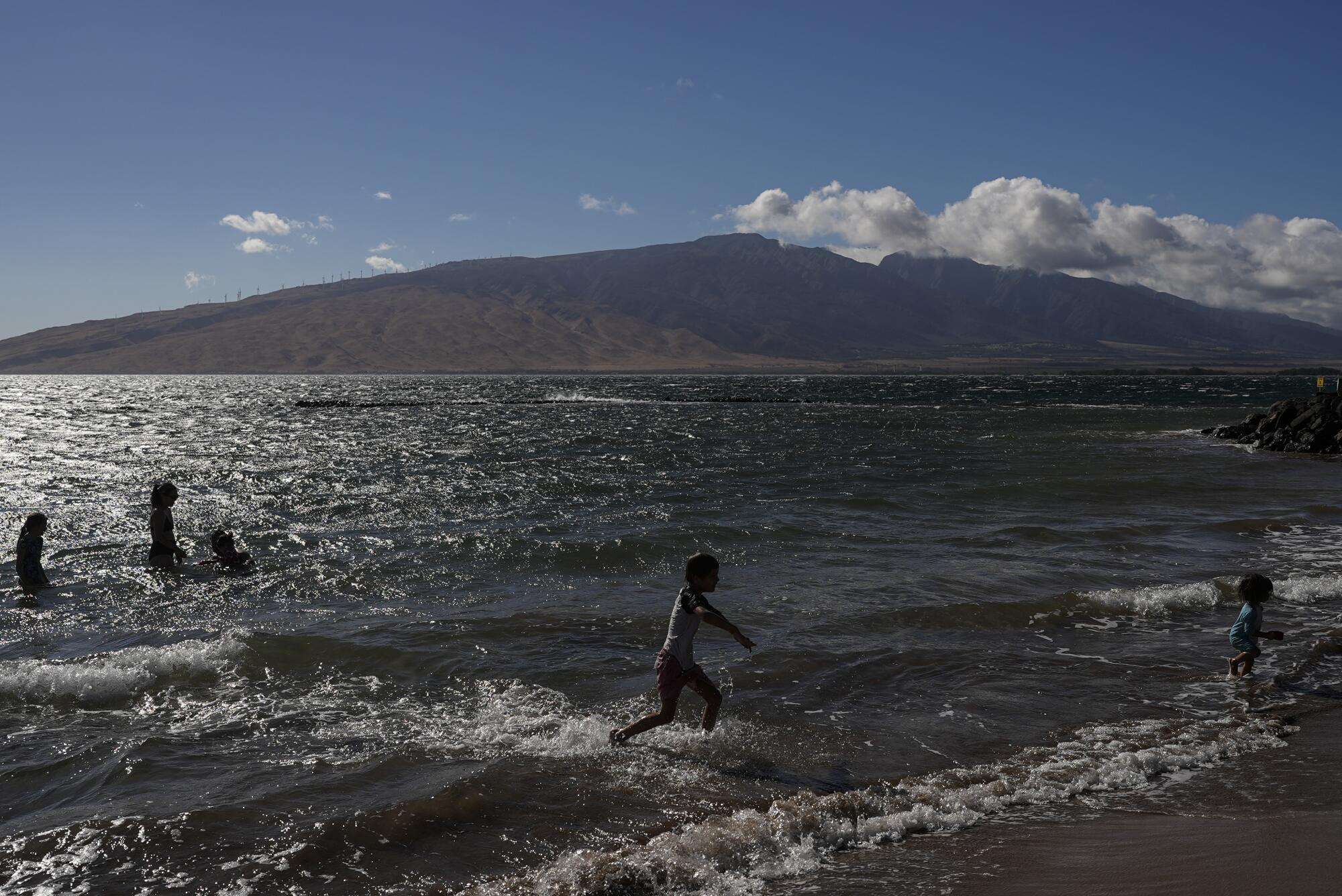
Some of the most outspoken voices telling visitors to stay away have softened their tone.
‘Āina Momona, a community organization whose Instagram post telling visitors to not travel to Maui went viral after it was shared by actor Jason Momoa and others right after the fire, put up a new Instagram slideshow Thursday. The message — directed at those who do decide to travel to Maui — urges tourists to avoid the affected areas, show empathy and compassion and ends with the “bottom line” that people should “visit,” “spend” and “go home.”
They thought the grass fire was contained, but wind conditions were still extreme. Now the decision to pull firefighters away shortly before the Maui fire reignited has become a flashpoint, as questions mount over whether more could have been done to stave off the destruction.
Trisha Kehaulani Watson, ‘Āina Momona’s co-founder, said the organization absolutely stood by its first message as the right response “in the immediate aftermath” of the fire, when people were still trying to gauge the devastation.
Now that the island was moving into a “different phase of recovery” with more clarity about the resources needed for relief efforts, Kehaulani Watson thought some level of tourism was necessary to feed the local economy.
The Lahaina fire burned through a roughly 3½-square-mile area, leaving horrific devastation in its path, and residents also lost homes in separate fires in the mountainous center of Maui. But those areas cover a tiny fraction of the 727-square-mile island.
“The fire was devastating. But if the economy doesn’t come back, then that means everybody who’s there and everyone around them is going to suffer as well,” said James Kunane Tokioka, director of Hawaii’s Department of Business, Economic Development and Tourism.
The Hawaiian Islands do see wildfire from time to time, but the catastrophic Maui fires were spawned by a striking mix of factors, including climate change.
Most other tourist hubs outside West Maui are at least a 40-minute drive from the devastation and bear no external sign of the nearby tragedy, save for scattered donation boxes and the void of tourists.
In West Maui alone — which previously accounted for about 15% of the tourism across all Hawaiian islands — there is an estimated economic loss of $9 million a day, according Tokioka. West Maui’s hotels remain closed to visitors, with many housing employees displaced by the fires.
There were 4,444 new unemployment claims filed in Maui last week, according to the state. That’s a staggering number in a county with about 129,000 adults — and a 3,603% increase from the 120 average weekly claims before the wildfire.
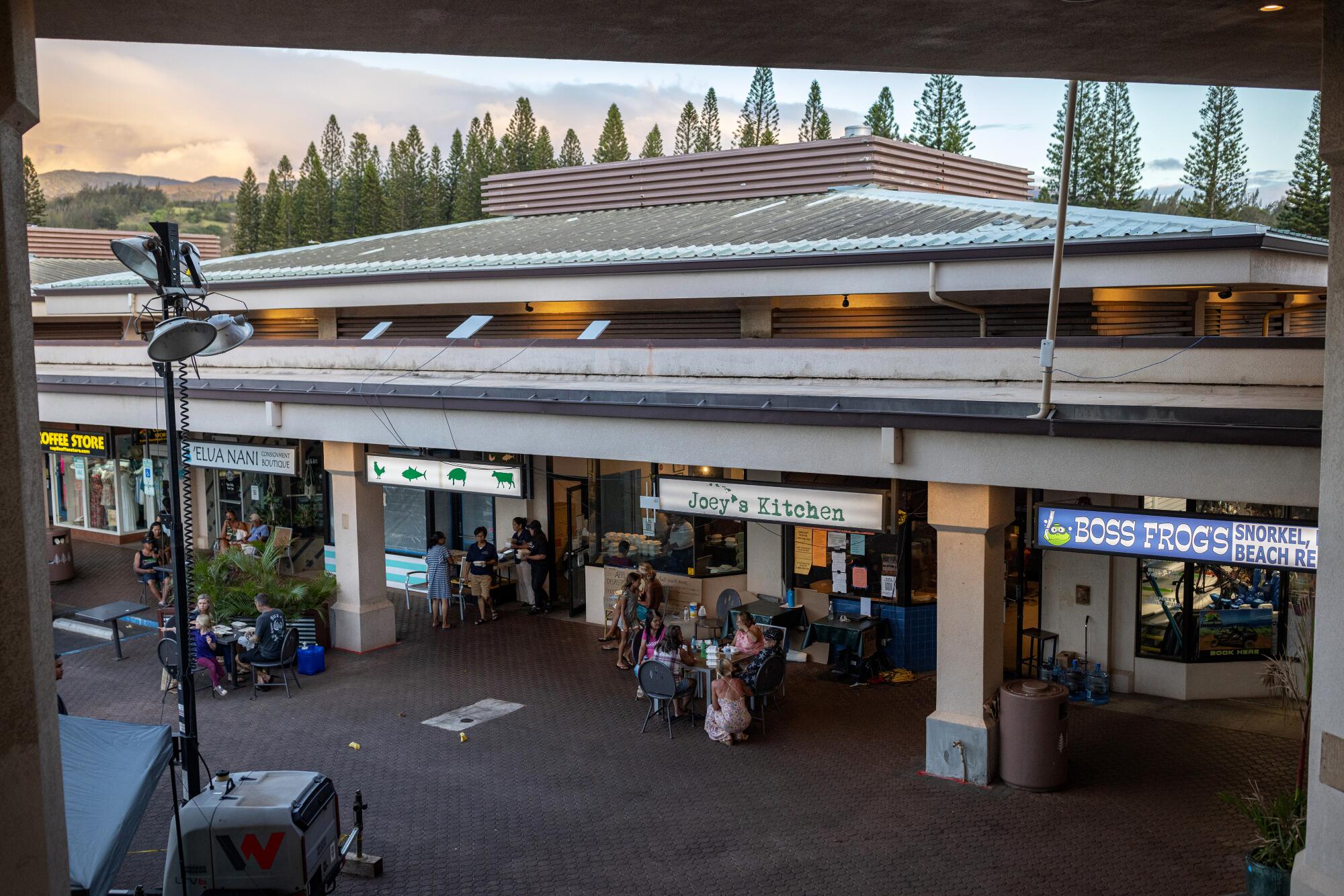
That number — which includes those who lost jobs to the fires in West Maui, as well as those affected by slowdowns on other parts of the island — is expected to climb in the weeks to come, according to State Chief Economist Eugene Tian.
Hawaii’s economic recovery from the COVID-19 pandemic has lagged behind that of other states, Tian said, with the state’s economic recovery at about 97% of what it was before the pandemic. “Because of this incident, I think full recovery will go beyond 2025,” Tian said.
More than two dozen tourism workers who spoke to The Times described deep anxiety about the immediate future and the effect that a protracted slowdown in tourism would have on the island and for them personally.
Many said they had already seen their shifts or hours cut, and most expressed a desire for travelers to keep visiting other parts of the island. They also spoke about their personal connections to the fires, and their sometimes complicated feelings about the tourist economy.
Those contending with profound loss and those dealing with the more quotidian realities of shortened shifts and looming layoffs are not necessarily in two separate camps.
Jowel and Relyn Delfin have taken 13 relatives into their central Maui home.
There are people who lost their homes sitting awake at night worrying about how they’ll rebuild their lives if they also lose their jobs, along with hospitality workers struggling to get through their shifts while reliving the traumas of the fire.
Ferrying customers to and from Kahului Airport, a rental car shuttle driver pointed out the wide lots of unrented cars lining the road — something she hadn’t seen since the COVID-19 pandemic shut down the island’s tourism industry in 2020.
On the rare occasions tourists get into her shuttle after the fire, she has taken to turning up the radio loud as soon as they enter the car. The woman, who was not authorized to speak publicly, said she doesn’t want them to stop coming — she and everyone she knows need the work, as she put it — but she just can’t bear to hear them chattering as though everything is normal.
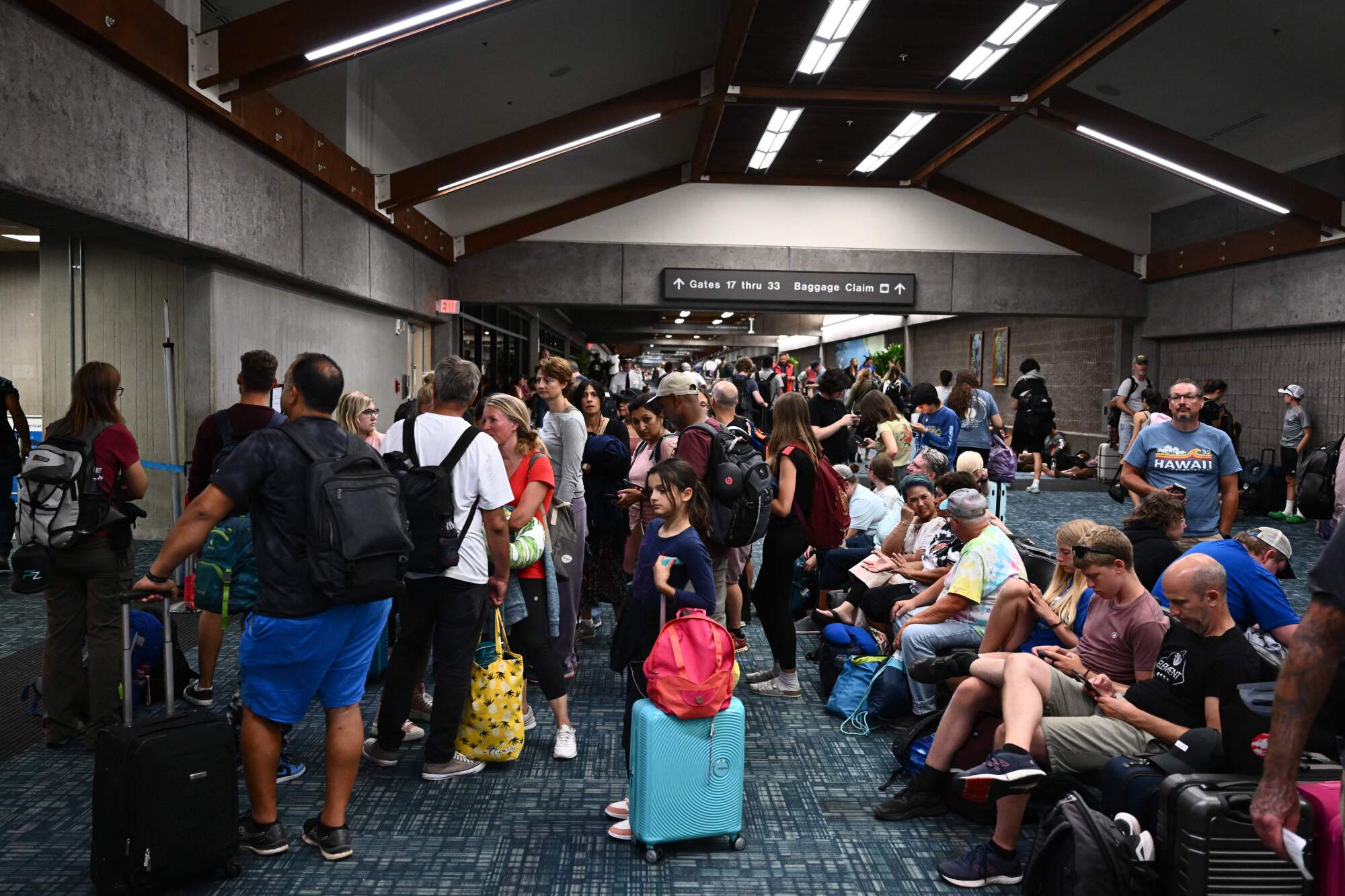
Inside the airport — the island’s primary entry point for visitors from the continental United States — most everyone from the Hawaiian-shirt clad waitress at a restaurant by the airline gates to the clerk ringing up last-minute souvenirs can dolefully cite the airport’s most recent passenger statistics.
They are, in a word, dismal.
On Tuesday, about 2,192 passengers arrived at Maui’s airport on domestic flights, according to estimates from the state. That’s a 67% drop from numbers for the same day in 2022. The average number of daily domestic arrivals for August so far is down 45% from last year, according to the same state data.
“Visitor counts from the mainland are at an all-time low” other than during the pandemic, Tokioka said.
Figures from lodging industry analyst CoStar show that as of Aug. 5, three days before the island fires reached emergency status, Maui’s hotels were 71% full. By Aug. 12 — with the death toll climbing and more than 1,000 people still missing on the island — rooms had begun emptying and CoStar estimated Maui’s overall hotel occupancy at 57%.
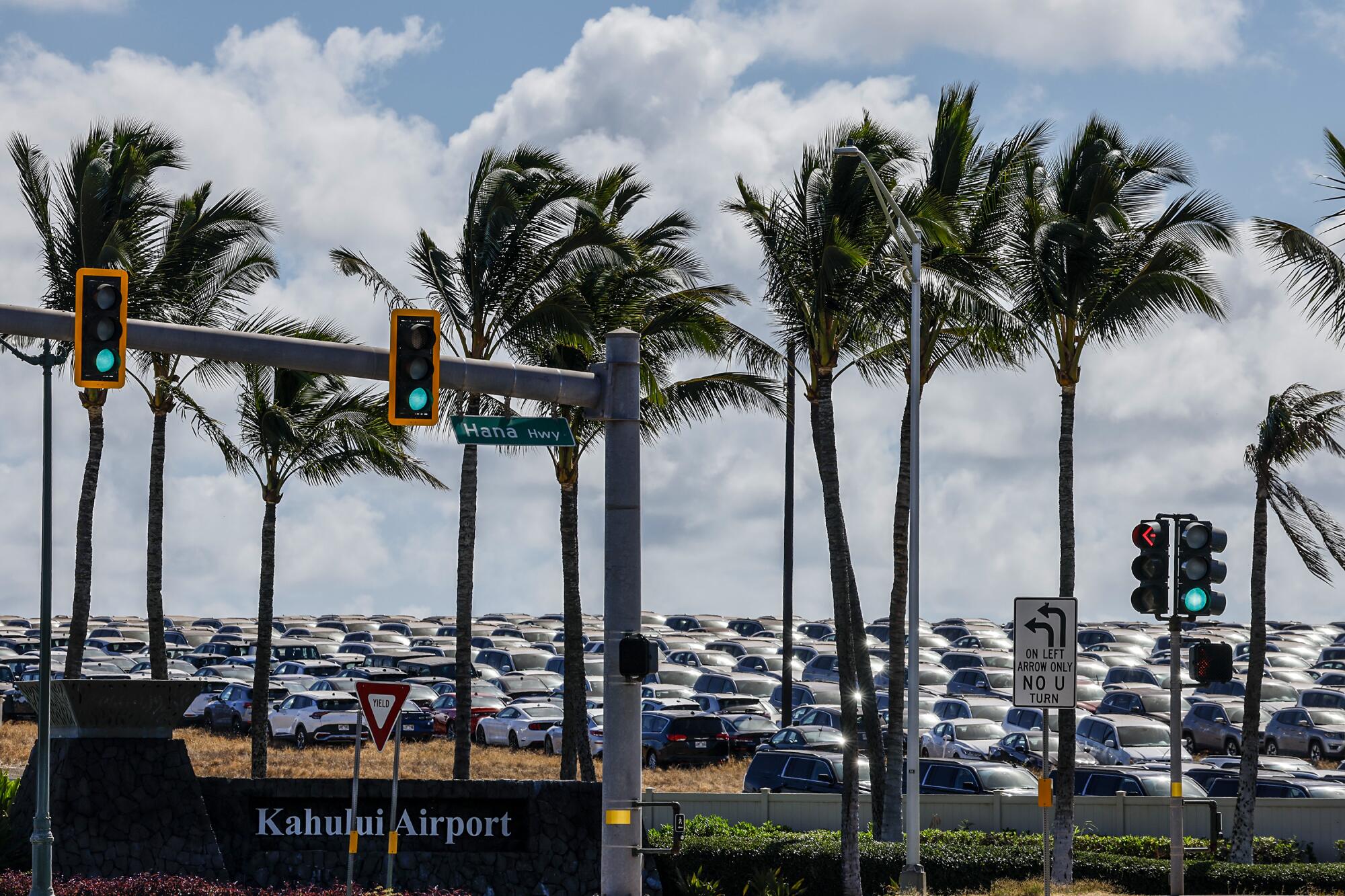
For the week ending Aug. 19, occupancy had dipped further, with CoStar estimating nearly half of Maui’s hotel rooms were empty — down more than 27% from a year before. Those statistics are for all rented rooms, including those filled by tourists, displaced Maui residents and emergency responders.
The island’s hotel rates averaged more than $600 per night in 2022 and even after the fires have remained above $450. Meanwhile, rental car rates have fallen below $50 a day and flights from LAX are available for less than $300.
“It was a ghost town all day today,” Maya, a small-business owner who declined to give her last name, said of foot traffic in Kihei’s Kalama Village — a charming cluster of stalls catering to tourists about a 25-mile drive down the coast from Lahaina. Her stall, which sells souvenirs and Christmas ornaments, had just three customers in the 11 hours she’d been open. Maya joked sadly that the sales wouldn’t even cover her gas money home.
She feared losing her business if visitors continued to avoid the island but also felt conflicted about voicing those fears when others had already lost so much more, she said.
As soon as he saw news of the Lahaina fire, Irvine resident Rollin Gordon canceled plans for a five-day Maui vacation with his wife that was supposed to kick off Monday. Gordon, 30, had an Airbnb booked for Wailea — an area neighboring Kihei known for its luxury hotels — but thought it was “insensitive and irresponsible” to travel there.
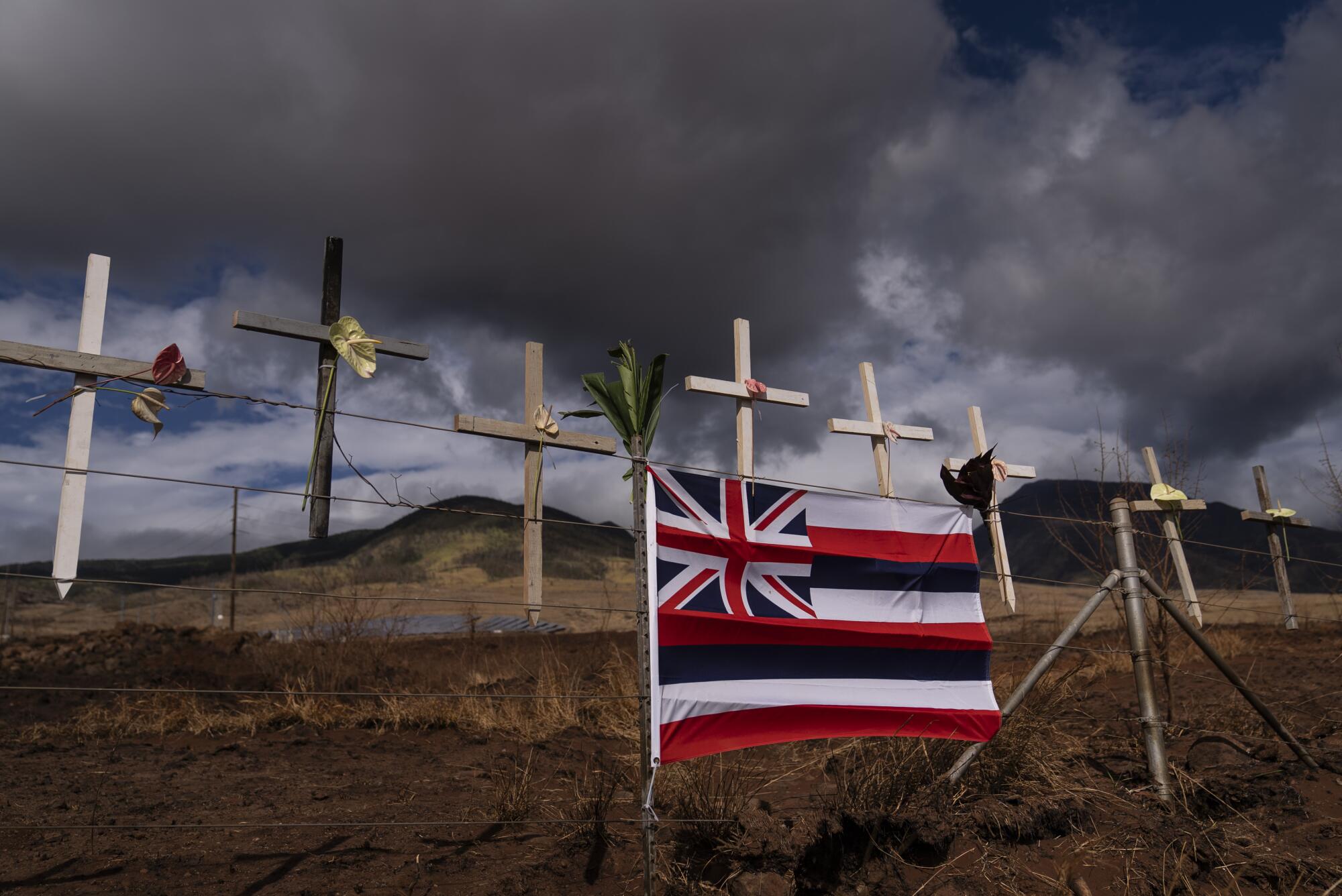
“The news reports have made it clear that thousands of people are in need of homes and proper infrastructure,” he said. “We do not wish to further burden the local community.”
Sara Hakan, a Lahaina evacuee who lost her home and her income source as a snorkel trip operator in Lahaina Harbor, said such a decision was the right one, even for people whose travels would take them to other parts of Maui.
“We cannot have tourists here right now,” Hakan said less than a week after the fire.
More than 10 days later, she felt a bit differently, saying Friday that she thought the rest of the island needed the business to keep functioning.
“But it’s a delicate balance,” Hakan said. “I don’t even know what the right thing is because the island needs time to heal at the same time that the economy needs to keep going.”
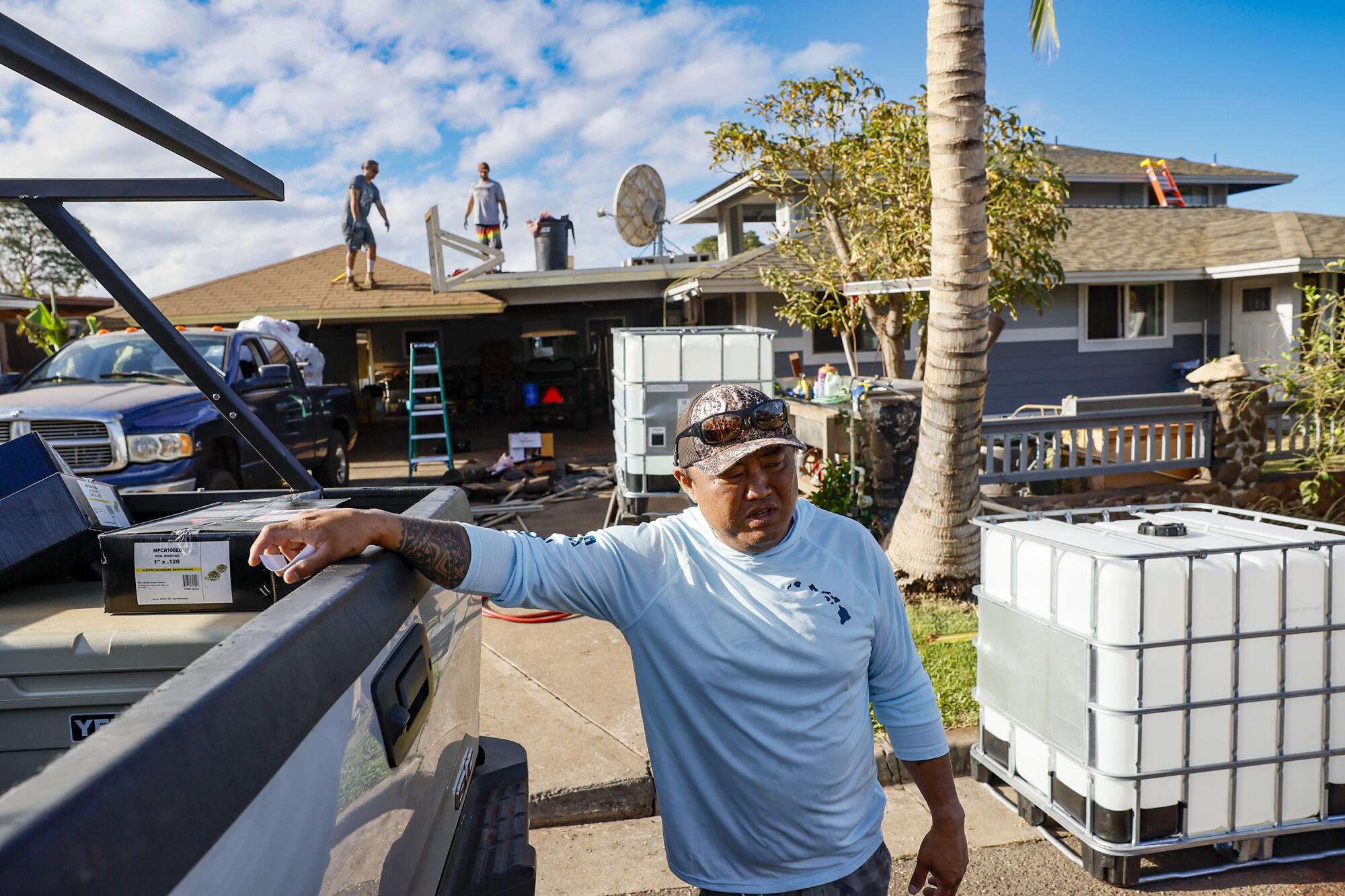
Sitting on a picnic bench in front of a postcard-perfect stretch of coastline not far from the ashes of his Lahaina home, Jeremy Delosreyes described tourism — and the way people feel about it — as one of the fundamental divides in the state.
The Native Hawaiian roofer personally wishes that the islands were far less reliant on tourism, but also recognizes it as “the economic driver of this state.” Still, he was resentful of the focus on the economic effects of fewer visitors when others — like him — had experienced such profound losses.
“It’s like well, you’re gonna lose your job, but you still have your home,” Delosreyes said. “So it’s a very dicey subject right now about tourism in Hawaii and on Maui. “
Angela Fa’anunu, assistant professor of sustainable tourism at the University of Hawaii at Hilo, said the topic of tourism in the state is so sensitive because it’s layered onto the history of colonialism. The Kingdom of Hawaii was illegally overthrown in 1893 with the aid of the U.S. armed forces and the islands became a state in 1959 — a one-sentence history that elides generations of further losses.
“Tourism doesn’t exist in a vacuum. It exists in a certain context,” Fa’anunu said, pointing to the history of marginalization and repression of Hawaii’s Native people, and the fact that visitors’ needs are often prioritized over those of locals.
Kainoa Horcajo, a cultural consultant and organizer with the mutual aid organization Maui Rapid Response, said it’s not uncommon for someone raised on the island to have family members who are vehemently anti-tourism, along with family members who work in and support the industry.
“Like any community, there’s a spectrum of sentiment. The main issue here is that this industry was developed and created by and for the benefit of foreigners,” he said, explaining “foreigners” includes those from the continental United States.
Horcajo, who is president of the Maui Native Hawaiian Chamber of Commerce board, thought that shifting toward a more locally led and locally created tourism economy would ease some of those tensions, and noted several efforts underway. But that will be a long road.
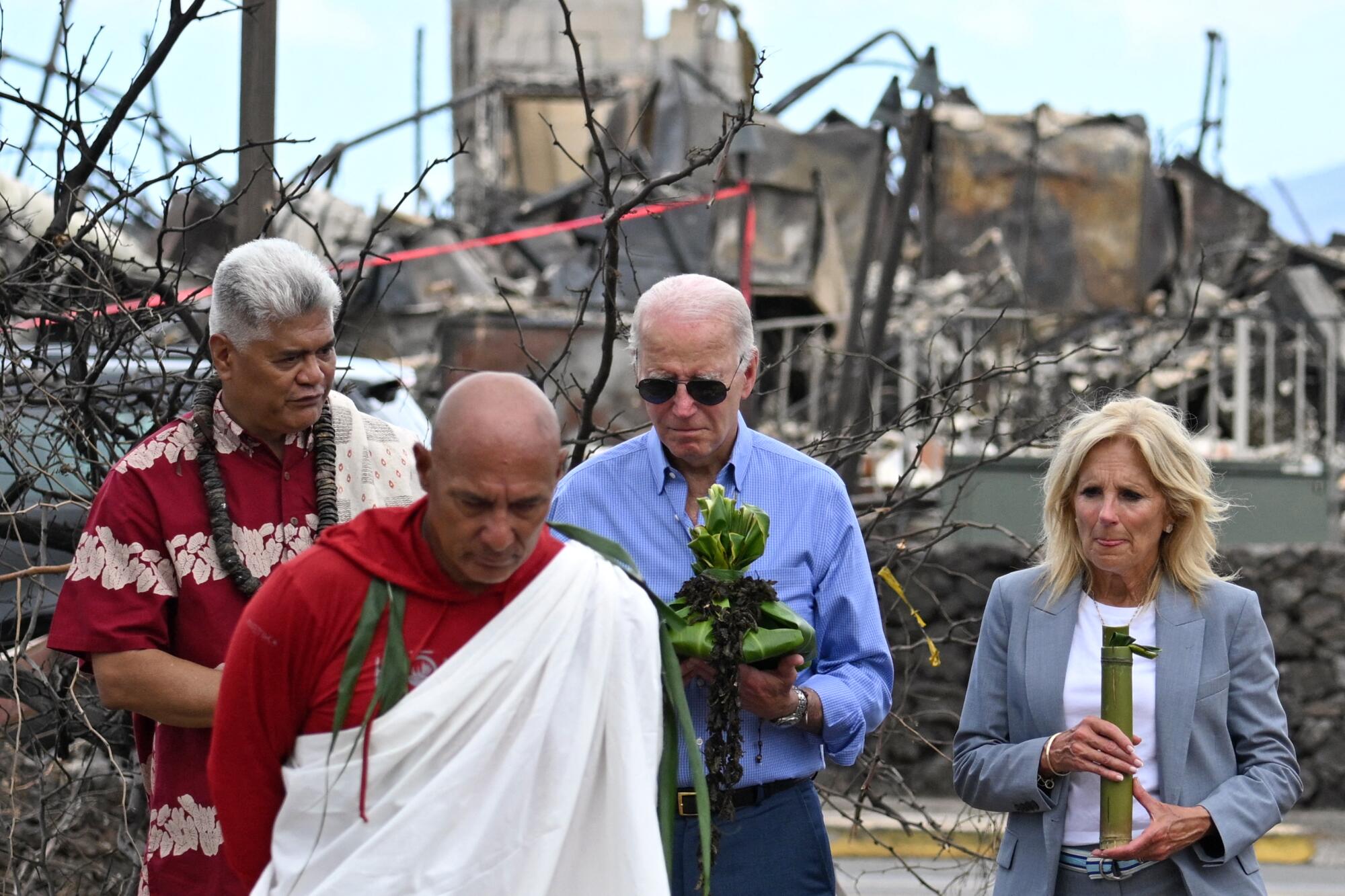
In the immediate term, he said, a nuanced message is needed: Don’t go to Lahaina or rubberneck around the ashes. But the rest of the island is open and needs your support.
At his family’s small bed and breakfast in Wailuku — far from the fires — guests have been canceling reservations all the way into December, Horcajo said.
It’s not just the business owners who are affected, Horcajo added. ”It’s the people that depend on tips. It’s the dishwashers. It’s the suppliers that are sending in the people that work for, you know, the food distribution companies and the trucking companies. There’s this whole network of people that depend upon this.”
Sean Greene contributed to this report.
More to Read
Sign up for Essential California
The most important California stories and recommendations in your inbox every morning.
You may occasionally receive promotional content from the Los Angeles Times.
